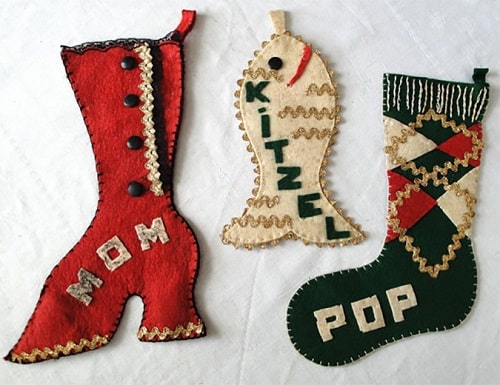by Judy Gonyeau
There is a tale that speaks to the heart of the winter holidays. Typically, this is a time when giving gifts to charity overcomes the disagreements and human entanglements that can sometimes keep people apart by bringing them together to support those in need. Such is the story – or stories – of the Christmas Stocking.
From the Christians
Perhaps one of the best-known renditions of the story is the one surrounding Saint Nicholas. Nicholas of Bari was born a nobleman in 280 A.D. in the city of Patara, Lycia – what is now known as Demre, Turkey. Nicholas lost his parents at an early age, and it is reported that he used his inheritance to help the poor and sick. As a young man, he became the Bishop of Myra and was immensely popular for his kind, generous heart. Living a life of celibacy, Nicholas never married or had children and was named “the gift-giver of Myra” for his generosity to them.
As the story goes, a poor widower living in the 4th century A.D. had three unwed daughters and was on the brink of destitution when his story was shared with St. Nicholas. Knowing the man would not take charity, Nicholas snuck into the house using the chimney and filled the girls’ stockings drying by the fire with gold coins (or later referred to as gold globes). The father now had dowries so his girls could marry well and he would not be alone and poor in his old age. He always gave his presents late at night in order to protect his identity. This folk tale has slight changes here and there depending upon who tells it, but the message is clear: be kind to those less fortunate.
For the Dutch, the tale of “Sinterklaas” alongside his assistant Blac Pete (“Zwarte Piet”) brought out the suggestion of stockings holding gifts. Each year the two would dock in the harbor of a different city and traveled the city riding a white steed and a mule. Children, hearing of their arrival, would place treats for the animals such as hay and carrots in their wooden clogs and leave them out in hopes that Sinterklaas and Zwarte Piet would ride past their house.
After enjoying the treats left for them Sinterklaas would reward the children for their thoughtfulness with small presents and treats they brought with them from foreign lands. They were simple gifts that would include candies, ornaments, nuts in shells, small toys, and other trinkets.
When the Dutch came to America and settled in New York they brought their traditions with them. After a while, Sinterklaas became known as Santa Claus and their clogs were replaced with stockings.
From the Norwegians
In a more fantastical version driven by Norse mythology comes the story of the chief god Odin and his flying horse Sleipnir. Here, the tale notes that the children would leave out boots filled with hay and treats for Sleipnir to enjoy during the pagan Yule celebration (generally around December 21). Odin would reward the children with thoughtful gifts and candy. There is one connection between the flying horse and the flying reindeer of Santa Claus – Sleipnir had eight legs, and Santa had eight reindeer. Coincidence?
From the Italians
The Italians tell of a witch named La Befana who decided not to go with the three wise men on their journey to Bethlehem to find Jesus. Later she regretted that decision and left to go on her own journey to bring gifts to the baby, but never found him, and gave the gifts to other children. Children still set out their shoes or stockings hoping La Befana will fill them on the day of the Epiphany (January 6).
There was another side to La Befana – she also was the originating factor to the tradition of bad children receiving coal or dark candy in their stocking. If children were naughty or unkind, they would not receive good candy, but less-sweet chocolate or a piece of coal.
From the Press
While the tales spread over the years, the actual use of stockings to be filled by Santa Claus can be dated to 1823 and the publishing of the poem A Visit of St. Nicholas attributed to Clement C. Moore … but is that attribution correct? Check out the Sidebar to learn more.
Prior to the publishing of the poem, families tended to use their own traditional approach to the use of stockings in the Yuletide season. Once the poem was published, stockings became a more prominent element of Christmas, at one point out-pacing the Christmas Tree as the primary symbol of the season. Different regions had different stockings; most notably the New England stocking was known to be smaller in size used by “stingy” folk, while the stockings in the Mid-west areas like Chicago—where money was being made hand over fist at the time—were so large just about anything could fit.
In an article from The New York Times came an “Ode to the Christmas Stocking-esque” style column espousing the qualities of the “Smith” Stocking, which solved the issue of size when it came to putting gifts inside as it was made from elastic. While the writer does take a moment to laud the benefits of using a stocking for holding gifts vs. placing them around the Christmas Tree, it was not until the early 1900s that both were used together more as decoration for the season than the meaning behind them.
In Puerto Rico, children celebrate Three Kings’ Day on January 6, putting boxes of cut grass for the kings’ camels under their bed the night before. The next morning they find a small toy in the box as thanks for their kindness.
In Hungary, St. Nicholas (called Szent Miklás) arrives on his feast day, December 6, and then leaves before Christmas. Tradition has it the children would place a boot on their windowsill to be filled by Miklás. The boots must be clean and shiny or they will be filled with onions, raw potatoes, and coal.
French children place their shoes by the fireplace with a treat in it for Père Noël’s donkey. They wake to find candy, money, or small toys in its place.
In China, children hang muslin stockings and wait for Dun Che Lao Ren (“Christmas Old Man”) to fill them.
Stockings Over Time
In the early 1800s, real socks and children’s stockings were used to hold gifts from Santa Claus, but over time the introduction of specially-made stockings began to take the place of the real ones. Many versions would be made by hand, often by the children themselves. While some companies started to create “pre-made” and “pre-filled” stockings, others made kits for parents and children to create personalized versions to decorate the mantle.
World War II
Soldiers serving overseas during WWII celebrated Christmas as best they could, and stockings were a part of it. Many soldiers would kneel down right there on the grounds of the battlefield for services while others would seek out local churches and enjoy a meager Christmas meal with residents. Decorations being what they were, Christmas stockings were hung with care onto rifles and small hand-crafted gifts or items would be exchanged.
Following the War, homemade designs became extremely popular as the “Baby Boom” took place. Craft stores sold large varieties of knits, stencils, and supplies for recreating the perfect stocking at home reminding everyone of a better time and of a promise for a brighter future.
Mid-Century and Beyond
As the marketing of Santa Claus kicked into high gear (Miracle on 34th Street told this tale when it came out in 1947), stockings throughout the 1950s typically featured Santa, his reindeer, and both in flight over a country home. It was not until the 1960s that the color red became the primary color for Christmas stockings.
Stockings also became marketing tools for other products. Some were filled with candy or other small gifts from certain manufacturers, and others had graphics highlighting Santa holding a Coke or Elves using Kodak cameras.
No matter what the age, the child in each of us always holds close those memories of opening the stocking to discover the personal treats from Santa just for us. Even if we are parents and grandparents today, having a stocking full of special treats always makes the holiday sweet.
The Night Before Christmas by … Henry Livingston?
Clement C. Moore has been credited with writing The Night Before Christmas over the past almost 200 years, but is that attribution correct? For the descendants of Henry Livingston, Jr. (1748-1828) the answer is no.
Here is the story:

1822: According to Livingston’s children, a governess who was visiting with the family then stopped by the Moore household on her way south to start a new job. The poem was a favorite of the family and it is believed she brought a copy with her for Moore to share with his six children.
1822: Dr. Clement C. Moore composes the poem A Visit from Santa Claus. He would later tell friends he was inspired by the beauty of the moonlight on snow on his way home from picking up a Christmas Goose. He went directly to his study and wrote the poem. His children were thrilled with his reciting of the poem, but Moore cautioned them not to let it out of the house. One of his children let Harriet Butler of Troy, NY take a copy with her when she left.
1823: On December 23, the Troy Sentinel printed A Visit from Santa Clause without attribution.
1830: N. Tuttle, owner of the Troy Sentinel who published an edited version of the poem along with an engraving by Myron B. King showing Santa with a sleigh and eight reindeer on a roof. (Note: Livingston had studied Lapland, the home of reindeer and regularly wrote of animals in flight in his other works.)
1837: The poem was printed in a book, New York Book of Poetry, with attribution. The book was published by Moore’s friend Charles Fenno Hoffman and did attribute it to Moore although Moore had not told anyone with the exception of family and friends that it was his. By this point, Livingston had been deceased nine years. The family did not come forth to contradict the information in the book.
1838: The Troy Budget acknowledged Moore’s authorship on December 25. The poem continued to gain in popularity, now with Moore’s name attached.
1844: Moore was encouraged to publish a group of his poetry by his children, but before doing so obtained a letter from Norman Tuttle stating Mrs. Sackett gave the poem to her husband and Troy Sentinel editor, Oliver Holley, after receiving it from Harriet Butler. Only after receiving the letter did Moore publish the poem in his book of poetry under his own name.
1920: The great-grandson of Livingston’s, William Sturgis Thomas, publicly stated his great-grandfather was the author of A Visit from St. Nicholas. At this point, Moore’s grandson obtained a deposition from a cousin who had witnessed Moore talking about what had inspired him to write the poem, and also had the letter from Tuttle regarding how the piece was obtained for publication. One problem: Tuttle’s copy of the poem published in 1830 which he included in the 1844 letter was edited—a lot—by Holley. This showed Moore did not recognize the differences between the original and the edited work, as he used this version going forward.
1977: A commemorative postcard was issued identifying Henry Livingston, Jr. as the author.
2000: The Vassar Professor Don Foster, known for his intense study of poetry and literature and their attribution, gets into the mix. He notes that the poem has all the bells and whistles of a poem constructed by Livingston. During an ABC NEWS interview that aired on December 24, 2000, Foster noted that the use of “Merry Christmas” was the popular phrase and used by later Moore publication, but “Happy Christmas,” used consistently by Livingston, was in the original publication.
2016: Auckland University Emeritus Professor MacDonald Jackson published the results of his multi-year research into the poem using a series of tests to state once and for all who wrote this classic Christmas poem. Tests analyzed phoneme pairs, and the use of the word “And” when starting a sentence. Throughout his career, Moore used the word 307 times out of 2873 lines, using a comma in 40 instances. Livingston used the word 212 times out of his 1892 lines and never used a comma. “And” is at the start of 12 lines out of the 56 in the poem and is never followed by a comma.
There is an overview of the evidence to date. Will Livingston have his authorship sanctioned by the powers that be? Some have said yes.











Related posts: